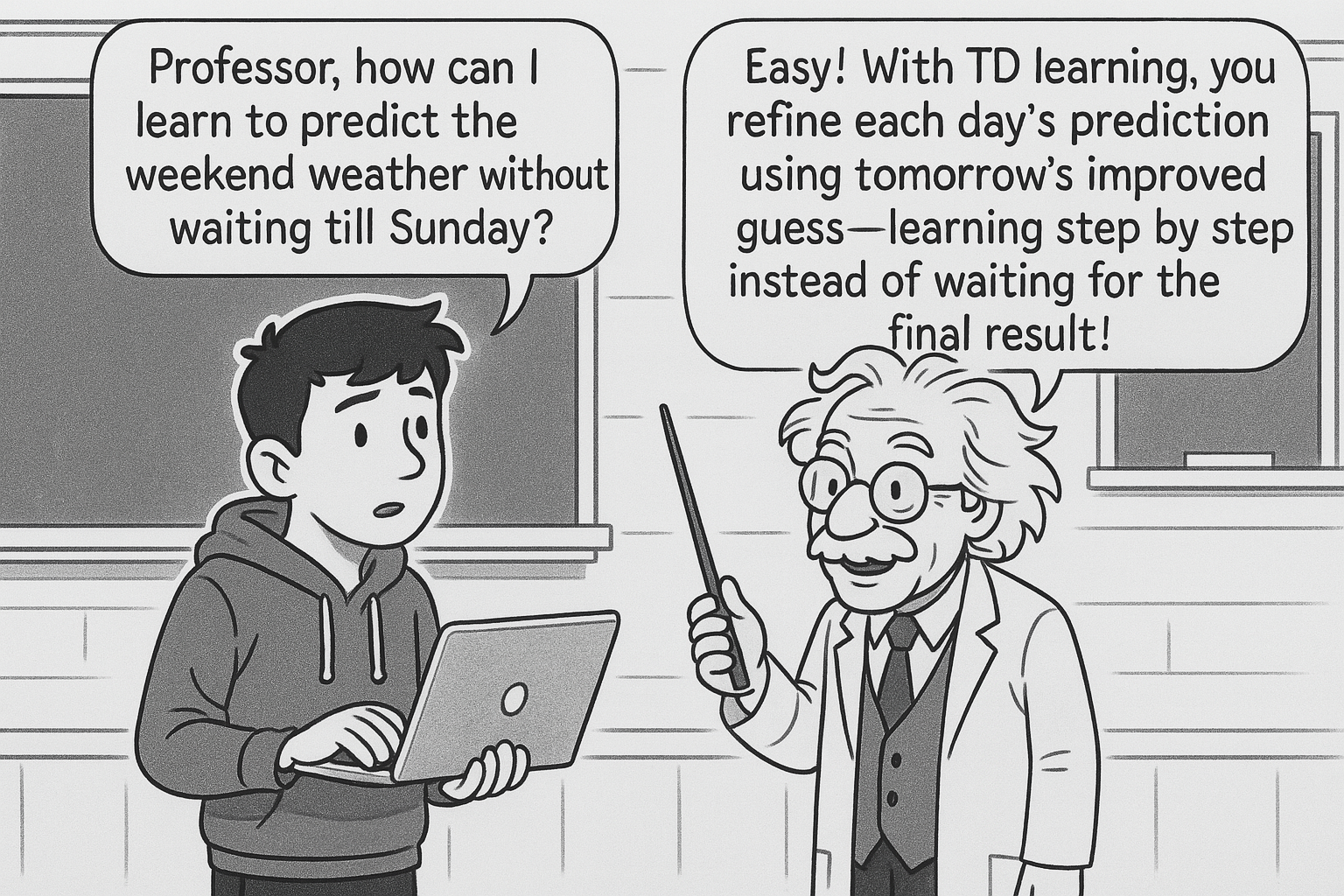Introduction
In 1988, Richard Sutton published a paper in Machine Learning that introduced temporal-difference (TD) learning, fundamentally changing how machines learn to make predictions about future events. "Learning to Predict by the Methods of Temporal Differences" presented a class of incremental learning procedures that could predict future behaviour of incompletely known systems using past experience. This work laid the mathematical foundation for modern reinforcement learning and challenged conventional prediction methods by learning from differences between successive predictions rather than final outcomes.
"Predictions are confirmed or disconfirmed not all at once, but rather bit by bit over successive temporal stages."
Core Ideas
Sutton's central innovation was elegant yet revolutionary. Traditional prediction-learning methods assign credit based on the difference between predicted and actual outcomes - you make a prediction, wait for the final result, then adjust based on how wrong you were. TD methods instead assign credit based on differences between temporally successive predictions, allowing learning to occur incrementally as new information becomes available.
The paper introduced the TD(λ) algorithm, where λ (lambda) is a parameter between 0 and 1 that controls how much credit is assigned to previous states. When λ=0, the algorithm becomes TD(0), which only updates the immediately preceding state. When λ=1, it becomes equivalent to supervised learning methods, updating all previous states equally based on the final outcome.
The mathematical foundation rested on the concept of temporal difference error - the difference between your current prediction and your updated prediction at the next time step. This error signal drives learning by bootstrapping from the agent's own predictions to improve earlier predictions in the sequence.
Sutton proved convergence and optimality for special cases, demonstrating that TD methods could learn accurate predictions whilst requiring less memory and computational resources than conventional approaches. The algorithm worked by maintaining eligibility traces that tracked which states were responsible for current predictions, allowing credit assignment across multiple time steps.
The paper showed that TD methods bridged the gap between Monte Carlo methods (which wait for final outcomes) and dynamic programming methods (which require complete models of the environment). This hybrid approach captured the best of both worlds: learning from experience like Monte Carlo methods whilst using bootstrap estimates like dynamic programming.
Breaking Down the Key Concepts
To understand TD learning, consider Sutton's famous weather prediction example. Traditionally, if you wanted to predict Saturday's weather on Monday, you'd observe Monday's conditions, wait until Saturday to see the actual weather, then adjust your Monday prediction based on how accurate it was.
TD learning works differently. On Tuesday, you make a new prediction for Saturday's weather based on Tuesday's conditions. Since Tuesday is closer to Saturday, this prediction is likely more accurate than Monday's. TD learning uses this improved Tuesday prediction to immediately update Monday's prediction, rather than waiting until Saturday.
This bootstrapping continues throughout the week. Wednesday's prediction updates Tuesday's, Thursday's updates Wednesday's, and so on. By Saturday, each day's prediction has been refined multiple times using information from subsequent, more accurate predictions.
The temporal difference error becomes the learning signal. If Tuesday's prediction is much different from Monday's, it suggests Monday's prediction needs significant adjustment. If they're similar, only small updates are needed. This error drives the learning process without requiring final outcomes.
The elegibility trace mechanism tracks how responsible each previous state was for the current prediction. Recent states get more credit (higher eligibility), whilst older states get less. The λ parameter controls how quickly this eligibility decays - higher λ values give more credit to distant states, whilst lower values focus on recent states.
Think of it like learning to navigate traffic. Instead of waiting until you reach your destination to evaluate your route choices, you continuously update your assessment of each decision based on how traffic conditions evolve. Each traffic light or turn provides new information that helps you evaluate previous choices.

Results and Significance
Sutton's theoretical contributions were substantial. He proved that TD(λ) methods converge to correct predictions under certain conditions and showed that they often require less computational resources than alternatives. The paper demonstrated that for most real-world prediction problems, TD methods produced more accurate predictions whilst using less memory and peak computation.
The practical validation came through several applications mentioned in the paper, including its use in Samuel's checkers player, Holland's bucket brigade algorithm, and Sutton's own Adaptive Heuristic Critic. However, the most dramatic validation arrived in 1992 when Gerald Tesauro applied TD learning to create TD-Gammon.
TD-Gammon used Sutton's TD(λ) algorithm combined with neural networks to learn backgammon purely through self-play. Starting from random initial play, it achieved a level just slightly below the world's best human players after 1.5 million games. More remarkably, TD-Gammon discovered unconventional strategies that revolutionised human backgammon play.
This paper represents the mathematical foundation underlying modern deep reinforcement learning systems. The TD learning principles appear in contemporary algorithms from recommendation systems to autonomous vehicle control. Every time you see an AI system learning from sequential decisions - whether it's a chatbot improving responses or a trading algorithm adapting to market conditions - you're witnessing applications of Sutton's core insights.
The paper's influence extended beyond its immediate applications. It established temporal-difference learning as a fundamental paradigm in machine learning, inspiring decades of research into reinforcement learning, neural temporal difference methods, and eventually deep reinforcement learning architectures like those powering modern AI breakthroughs.
The work also provided crucial theoretical grounding for the field. By proving convergence properties and relating TD methods to existing supervised learning techniques, Sutton gave the research community confidence that these methods could be trusted for serious applications.
Original paper can be found here - http://incompleteideas.net/papers/sutton-88-with-erratum.pdf